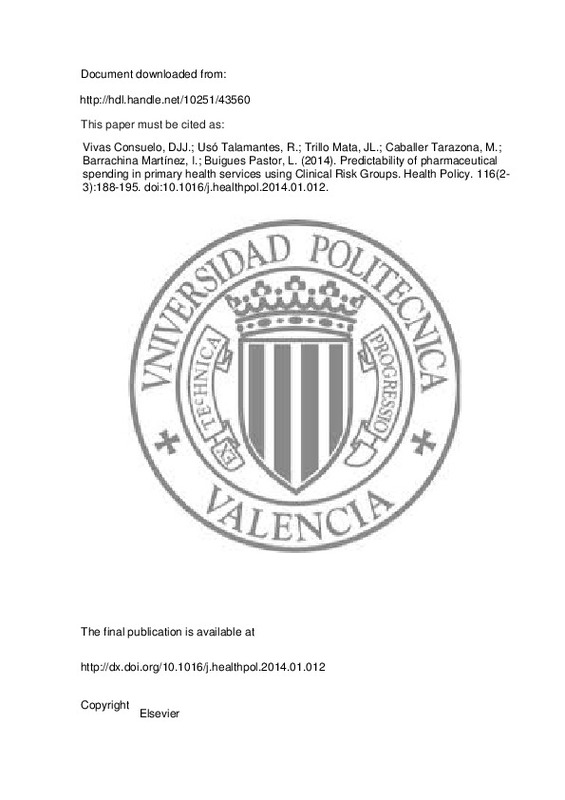JavaScript is disabled for your browser. Some features of this site may not work without it.
Buscar en RiuNet
Listar
Mi cuenta
Estadísticas
Ayuda RiuNet
Admin. UPV
Predictability of pharmaceutical spending in primary health services using Clinical Risk Groups
Mostrar el registro sencillo del ítem
Ficheros en el ítem
| dc.contributor.author | Vivas Consuelo, David José Juan
|
es_ES |
| dc.contributor.author | Usó Talamantes, Ruth
|
es_ES |
| dc.contributor.author | Trillo Mata, José Luis
|
es_ES |
| dc.contributor.author | Caballer Tarazona, María
|
es_ES |
| dc.contributor.author | Barrachina Martínez, Isabel
|
es_ES |
| dc.contributor.author | Buigues Pastor, Laia
|
es_ES |
| dc.date.accessioned | 2014-10-23T15:58:48Z | |
| dc.date.available | 2014-10-23T15:58:48Z | |
| dc.date.issued | 2014-06 | |
| dc.identifier.issn | 0168-8510 | |
| dc.identifier.uri | http://hdl.handle.net/10251/43560 | |
| dc.description.abstract | Background: Risk adjustment instruments applied to existing electronic health records and administrative datasets may contribute to monitoring the correct prescribing of medicines. Objective: We aim to test the suitability of the model based on the CRG system and obtain specific adjusted weights for determined health states through a predictive model of pharmaceutical expenditure in primary health care. Methods: A database of 261,054 population in one health district of an Eastern region of Spain was used. The predictive power of two models was compared. The first model (ATC-model) used nine dummy variables: sex and 8 groups from 1 to 8 or more chronic conditions while in the second model (CRG-model) we include sex and 8 dummy variables for health core statuses 2-9. Results: The two models achieved similar levels of explanation. However, the CRG system offers higher clinical significance and higher operational utility in a real context, as it offers richer and more updated information on patients. Conclusions: The potential of the CRG model developed compared to ATC codes lies in its capacity to stratify the population according to specific chronic conditions of the patients, allowing us to know the degree of severity of a patient or group of patients, predict their pharmaceutical cost and establish specific programmes for their treatment. (C) 2014 Elsevier Ireland Ltd. All rights reserved. | es_ES |
| dc.description.sponsorship | This study was financed by a grant from the Fondo de Investigaciones de la Seguridad Social Instituto de Salud Carlos III, the Spanish Ministry of Health (FIS PI12/0037). The authors would like to thank members (Juan Bru and Inma Sauri) of the Pharmacoeconomics Office of the Valencian Health Agency. The opinions expressed in this paper are those of the authors and do not necessary reflect those of the afore-named. Any errors are the authors' responsibility. We would also like to thank John Wright for the English editing. | en_EN |
| dc.language | Español | es_ES |
| dc.publisher | Elsevier | es_ES |
| dc.relation.ispartof | Health Policy | es_ES |
| dc.rights | Reserva de todos los derechos | es_ES |
| dc.subject | Risk adjustment | es_ES |
| dc.subject | Pharmacy expenditure | es_ES |
| dc.subject | Clinical Risk Groups | es_ES |
| dc.subject | WHO-ATC-Code | es_ES |
| dc.subject.classification | ECONOMIA APLICADA | es_ES |
| dc.subject.classification | ECONOMIA, SOCIOLOGIA Y POLITICA AGRARIA | es_ES |
| dc.title | Predictability of pharmaceutical spending in primary health services using Clinical Risk Groups | es_ES |
| dc.type | Artículo | es_ES |
| dc.identifier.doi | 10.1016/j.healthpol.2014.01.012 | |
| dc.relation.projectID | info:eu-repo/grantAgreement/MINECO//PI12%2F00037/ES/Análisis y modelización del gasto farmacéutico utilizando Clinical Risk Group/ | es_ES |
| dc.rights.accessRights | Abierto | es_ES |
| dc.contributor.affiliation | Universitat Politècnica de València. Departamento de Economía y Ciencias Sociales - Departament d'Economia i Ciències Socials | es_ES |
| dc.contributor.affiliation | Universitat Politècnica de València. Centro de Ingeniería Económica - Centre d'Enginyeria Econòmica | es_ES |
| dc.description.bibliographicCitation | Vivas Consuelo, DJJ.; Usó Talamantes, R.; Trillo Mata, JL.; Caballer Tarazona, M.; Barrachina Martínez, I.; Buigues Pastor, L. (2014). Predictability of pharmaceutical spending in primary health services using Clinical Risk Groups. Health Policy. 116(2-3):188-195. https://doi.org/10.1016/j.healthpol.2014.01.012 | es_ES |
| dc.description.accrualMethod | S | es_ES |
| dc.relation.publisherversion | http://dx.doi.org/10.1016/j.healthpol.2014.01.012 | es_ES |
| dc.description.upvformatpinicio | 188 | es_ES |
| dc.description.upvformatpfin | 195 | es_ES |
| dc.type.version | info:eu-repo/semantics/publishedVersion | es_ES |
| dc.description.volume | 116 | es_ES |
| dc.description.issue | 2-3 | es_ES |
| dc.relation.senia | 254372 | |
| dc.contributor.funder | Ministerio de Economía y Competitividad | es_ES |







![[Cerrado]](/themes/UPV/images/candado.png)

